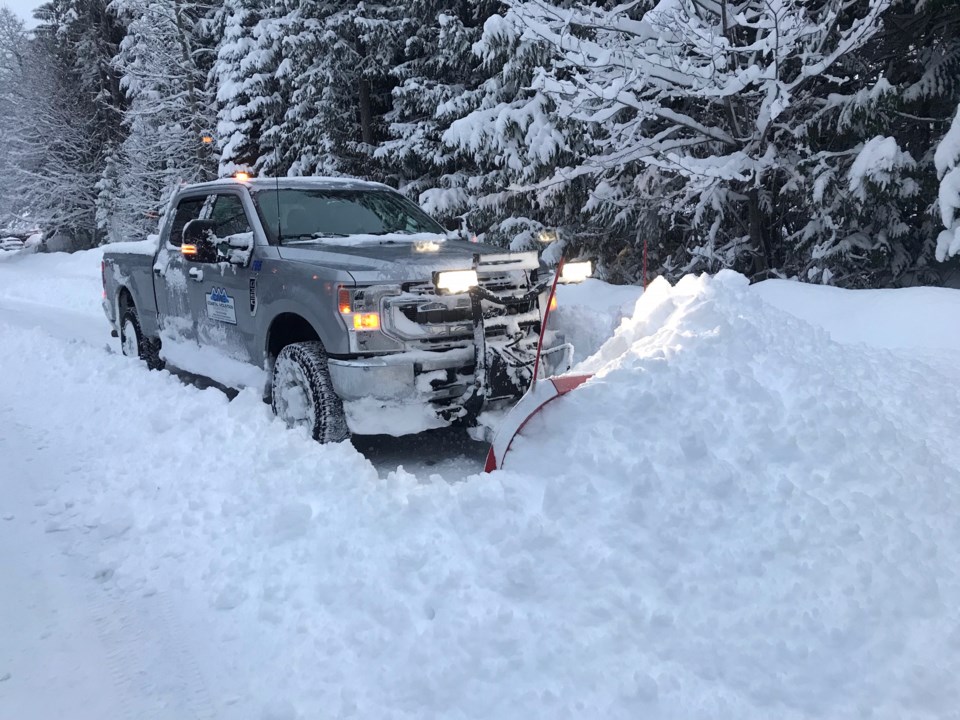More than 100 centimetres of snow has fallen over Whistler since New Year’s Day.
It’s meant endless, chest-deep pow runs and shaky legs for those able to make it up the mountain, but it’s also meant slippery, snow-covered roads, compounded holiday traffic, and a whole lot of shovelling in the valley.
The people responsible for keeping this storm cycle from bringing the entire resort to a standstill are those who’ve spent the first few days of 2022 working tirelessly to clear roads and parking lots, making it possible for locals and visitors to get around town safely.
But on a 50-cm-plus snow day, how big of a job is that, really? Pique caught up with Tim Coulson, chief operations officer of Coastal Mountain Excavations (CME)—who business partner Matt Woods, CME president, called “the single most experienced person in Whistler in regards to snow removal,”—to find out. (While he was in a sand truck, plowing, stuck in holiday Monday afternoon traffic on Jan. 3, for the record.)
On staffing
On a day like Sunday, Jan. 2, CME would have between 45 and 55 staff, from drivers to mechanics, on the clock, said Coulson.
“We’re OK. We’ve got long-term staff, and we have a pretty good program for our staff that makes them want to work for us, and they’re experienced. So we’re doing pretty good and we haven’t had much Omicron [affect us], so we’re really, really fortunate,” he said.
“It’s definitely around, but we all work individually in our equipment so we’re very low-risk at work, obviously … But with snow-clearing, it’s all about the staff and their experience, and we’re just holding in there. And we’ve been around long enough too—we’ve been here for 44 years, I think it is.”
On equipment
“We probably have 40 pieces of equipment. We have more [snow-clearing] equipment than the City of Vancouver.
“We have 30 loaders, and then we’ve probably got another 10—maybe more actually—sand tracks and plow trucks.”
On timing
“We have about 350 commercial clients and about 360 residential clients. So on a snow day, we can have up to 700 clients.
“With all that equipment on a 10- to 15-centimetre day, when everything’s up to speed, it’s probably an eight-hour day. But [on Sunday] … a lot of the guys probably did at least 12 hours, probably some did more, and then they were back again [Monday].”
On challenges
“In the old days, you’d go into a subdivision and there was always empty lots—and I remember this really, really well—places like Northern Lights, we used to dump the snow in the middle of this plot, in the middle of the condos. And then everybody got into the landscaping game, where one guy landscaped his condo, and he sold it for $100,000 more than the guy’s that wasn’t landscaped, so they took all the snow dumps away and put landscaping in. So now there’s nowhere to put snow … [Usually], we pick a spot and fill it in, and then we truck snow—that’s another huge part of our business. Like on a normal year, we’ll truck about four-and-a-half thousand loads of snow.
“If you drive into Marketplace and look at that pile of snow, that all has to get trucked out somewhere, and the cost of that is quite substantial. And the timing—so not only does it have to be safe to put trucks on the road, which hasn’t happened yet, [but we need to] have a break in the weather to truck the snow. From these storms, if it stops snowing now, we’d probably be busy for two weeks.”
On expectations
Snow clearing “is a very big business. It’s interesting, because if it doesn’t snow nobody cares about you, but when it snows, everybody wants you.”
While CME has plenty of “great, long-term clients,” said Coulson, his message to the community is to “just be patient” on heavy snow days.
“As I said, on a day that normally takes eight hours and turns into 12, there’s obviously going to be a big difference in our response time. It may not be perfect on the day you get 50 centimeters, but we’ll just keep coming back to try and get to where we need to be. Our goal is to get everybody moving safely. We do the ambulance station, the medical center. They are our biggest priorities at night, to make sure everybody can get an ambulance and get to the clinics for medical [treatment] … we’re dealing with Mother Nature and it will do what it wants. [We’ve seen it this year in B.C.] with floods and landslides, and snow, it’s just another one.”




